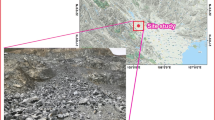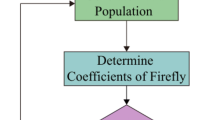Abstract
Rockburst is an important accident scenario in deep underground engineering. Because there are numerous, complicated factors that lead to rockbursts, their forecasting is a difficult task, which, based on an engineering analogy and geological analysis, requires the use of clustering methods in rockburst forecasts. Because the environmental causes of rockbursts are complicated, this clustering problem makes for a complicated random optimization problem (that is also a fuzzy optimization problem) that cannot be solved in a satisfactory manner using traditional methods. To improve the computational efficiency and accuracy of the traditional ant colony clustering algorithm, an abstraction ant colony clustering algorithm using a data combination mechanism is proposed. Based on an analysis of rockburst sample data and using an engineering analogy thinking by the abstraction ant colony clustering algorithm, a new method for forecasting rockbursts in deep underground engineering is proposed. A set of common engineering examples are used to verify the new algorithm. The engineering applications prove that, compared with the traditional ant colony clustering algorithm and based on their similar computational difficulty and complexity, the abstraction ant colony clustering algorithm produces results that are not only more accurate but are also determined more efficiently. As the complexity of the problem increases, the algorithm’s computational efficiency increases. In other words, the more complicated the problem is, the more efficient the algorithm becomes. Thus, the abstraction ant colony clustering algorithm is well suited to large complicated engineering problems.













Similar content being viewed by others
References
Ashish G, Anindya H, Megha K (2008) Aggregation pheromone density based data clustering. Inf Sci : Int J 178:2816–2831
Board M, Fairhurst C (1984) Rockbursts: prediction and control. The Institution of Mining and Metallurgy, London
Bonabeau E, Dorigo M, Theraulaz G (1999) Swarm intelligence: from natural to artificial system. Oxford University Press, New York
Deneubourg JL, Goss S, Franks N (1991) The dynamics of collective sorting: robot-like ant and ant-like robot. Proceedings of first conference on simulation of adaptive behavior: from animals to animats. MIT Press, New York, pp 356–365
Dong LJ, Li XB, Peng K (2013) Prediction of rockburst classification using random forest. Trans Nonferrous Metal Soc China 23:472–477
Driad-lebeau L, Lahaie F, Al Heib M (2005) Seismic and geotechnical investigations following a rockburst in a complex French mining district. Int J Coal Geol 64:66–78
Gao W (2009) Forecasting of rockburst based on ant colony clustering algorithm. In: Tang CA (ed) Controlling seismic hazard and sustainable development of deep mines. Rinton Press, New York, pp 1141–1146
Gao W, Yin ZX (2011) Modern intelligent bionics algorithm and its applications. Science Press, Beijing (in Chinese)
Li T, Cai MF, Cai M (2007) A review of mining-induced seismicity in China. Int J Rock Mech Min Sci 44:1149–1171
Lumer E, Faieta B (1994) Diversity and adaptation in populations of clustering ants. Proceedings of third international conference on simulation of adaptive behavior: from animals to animats. MIT Press, New York, pp 499–508
Pei L, Yang ZR (2008) Prediction of rockburst based on RBF neural network. Coal Technol 27:137–139 (in Chinese)
Ramos V, Merelo JJ (2002) Self-organized stigmergic document maps: environment as a mechanism for context learning. In: AEB’2002-1st Spanish conference on evolutionary and bio-inspired algorithms. Mérida, 284–293
Sharan SK (2007) A finite element perturbation method for the prediction of rockburst. Comput Struct 85:1304–1309
Song CS, Li DH (2007) Artificial neural networks for predicting rockburst in deep mining. In: International Symposium on Safety Science and Technology, 846–851
Wang YH, Li WD, Lee PKK (1998) Method of fuzzy comprehensive evaluations for rockburst prediction. Chin J Rock Mech Eng 17:493–501 (in Chinese)
Yang Y, Kamel M (2003) Clustering ensemble using swarm intelligence. IEEE swarm intelligence symposium. IEEE Press, New York, pp 65–71
Zhou J, Li XB, Shi XZ (2012) Long-term prediction model of rockburst in underground openings using heuristic algorithms and support vector machines. Saf Sci 50:629–644
Acknowledgments
The financial support from The Fundamental Research Funds for the Central Universities under Grant No. 2014B17814, 2014B07014 is gratefully acknowledged.
Author information
Authors and Affiliations
Corresponding author
Rights and permissions
About this article
Cite this article
Gao, W. Forecasting of rockbursts in deep underground engineering based on abstraction ant colony clustering algorithm. Nat Hazards 76, 1625–1649 (2015). https://doi.org/10.1007/s11069-014-1561-1
Received:
Accepted:
Published:
Issue Date:
DOI: https://doi.org/10.1007/s11069-014-1561-1




